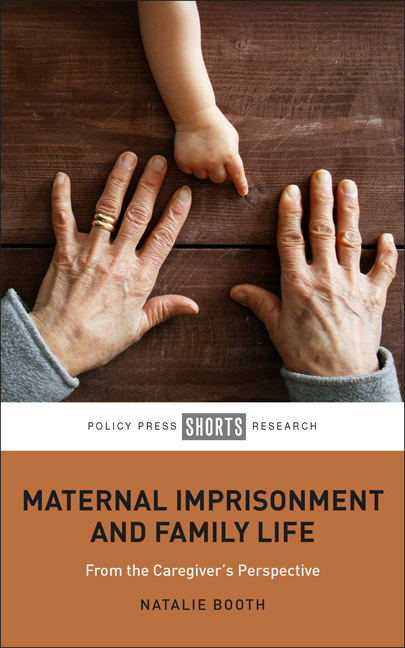Book contents
- Frontmatter
- Contents
- List of Tables
- Acknowledgements
- Preface: Linda’s Story
- One The Landscape of Maternal Imprisonment: Caregiving and Family Life
- Two Researching the Caregiver’S Lived Experiences
- Three Family Constructions and Caregiving Practices
- Four Renegotiating Family Life: Caregiving in the Aftermath of the Mother’S Imprisonment
- Five Navigating the Criminal Justice System
- Six Social Support, Familial Stigma and Release
- Seven Kin Caregiving: Occupying a Disenfranchised Status While Serving the Family Sentence
- Eight Reflections on the Research Process
- References
- Index
Three - Family Constructions and Caregiving Practices
Published online by Cambridge University Press: 10 March 2021
- Frontmatter
- Contents
- List of Tables
- Acknowledgements
- Preface: Linda’s Story
- One The Landscape of Maternal Imprisonment: Caregiving and Family Life
- Two Researching the Caregiver’S Lived Experiences
- Three Family Constructions and Caregiving Practices
- Four Renegotiating Family Life: Caregiving in the Aftermath of the Mother’S Imprisonment
- Five Navigating the Criminal Justice System
- Six Social Support, Familial Stigma and Release
- Seven Kin Caregiving: Occupying a Disenfranchised Status While Serving the Family Sentence
- Eight Reflections on the Research Process
- References
- Index
Summary
Introduction
This chapter examines the nature and scope of caregiving practices within families to better understand how families can be constructed during maternal imprisonment. Although there is growing international awareness of the ‘collateral consequences’ of imprisonment on children and families (Gordon, 2018; Condry and Scharff Smith, 2018), Jardine (2018) suggests that this has tended to focus narrowly on the prisoners’ immediate families. There is much still to be learned about the caregiving arrangements within families and the ways in which these can shape family life during maternal imprisonment. Importantly, caregivers in this study explained how the repercussions of losing the mothers to prison were felt by many relatives and friends within their kinship networks. Although varied and complex, this depended upon their family constructions, interactions and engagement in – or exposure to – caregiving practices. The three distinct characteristics that were observed within families are discussed in this chapter.
First, the joint interviews (see Chapter Two) reveal something important about the way in which families were collectively responding to the mothers’ imprisonments. Both the joint interviews and caregivers’ descriptions show the meaning, nature and value of collective caregiving practices within the families, facilitating nuanced insights into the families’ shared responses to the mothers’ imprisonments. The value of using Morgan's (2011) theoretical concept of ‘family practices’ is apparent as discussions about ‘family’ are active, subjectively defined and not restricted to the household (see Chapter Two).
Second, following previous research (Caddle and Crisp, 1997; Raikes, 2016), the majority of the children were being looked after by women, either solely or alongside their partners or other female kin. Codd (2008) has argued that caregiving and support for prisoners and their children falls to female relatives in the family. The findings here not only support these gendered caregiving trends, but also indicate that during a mother's imprisonment, it is maternal kin who take on these responsibilities. Importantly, the new caregiving responsibilities for these women had implications for their own children and other grandchildren in the family. Therefore, it is important that discussions about maternal imprisonment consider the needs and experiences of this other group of ‘doubly’ invisible children.
- Type
- Chapter
- Information
- Maternal Imprisonment and Family LifeFrom the Caregiver's Perspective, pp. 41 - 66Publisher: Bristol University PressPrint publication year: 2020



